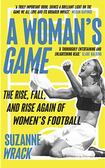
It was back in 1895 that the newly formed British Ladies’ Football Club (BLFC) played its first match, the occasion prompting an editorial in the London Evening Standard that was a touch unsupportive. “We hope it will be their last,” it read, “in a very short time the Club will die a natural and unlamented death”.
Why unlamented? Because “it cannot be pretended that football is either a decent or an elegant occupation for girls, and we can only regard the new Club as a passing whim, an ephemeral vulgarity”.
While today’s women’s football is hardly without its detractors, a fair old distance has been travelled since the “ephemeral vulgarity” days, a journey that is expertly traced by The Guardian’s Suzanne Wrack in her book, ‘A Woman’s Game: The Rise, Fall, and Rise Again of Women’s Football’.
No more than the women of the BLFC, Wrack is something of a trailblazer herself, the first person to be appointed as a women’s football correspondent by a British newspaper, and with her depth of knowledge of the roots of the game, few would be better placed to write its history.
READ MORE
She includes several pearls of press reports from the earliest days, including the Standard’s editorial, that give a flavour of the derision and hostility that greeted the pioneers of women’s football.
But there are also plenty of surprising tales of the numbers of women who played football as far back as the 18th century, including the married and unmarried women of the village of Inveresk in East Lothian who squared up once a year “with an audience of bachelors casting their eyes over the footballing skills of potential partners”. The niftier the skills, the more chance they had of landing themselves a husband. The bachelors of Inveresk were pioneers themselves.
In light of the significant, hard-won progress made by women’s football in recent years, this is a timely book, tracking the road to the record attendances, equal pay agreements, ever increasing television coverage and sponsorship deals that have made the headlines of late.
But it’s not a PR job for the sport, pointing, as it does, to the innumerable problems that the women’s game still faces, and suggesting a path ahead and a way of addressing them. It might no longer be an ephemeral vulgarity, but there’s still some way to go in the journey yet.
















